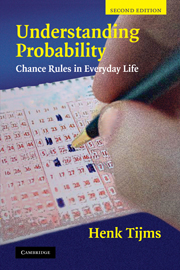Book contents
- Frontmatter
- Contents
- Preface
- Introduction
- PART ONE PROBABILITY IN ACTION
- PART TWO ESSENTIALS OF PROBABILITY
- 7 Foundations of probability theory
- 8 Conditional probability and Bayes
- 9 Basic rules for discrete random variables
- 10 Continuous random variables
- 11 Jointly distributed random variables
- 12 Multivariate normal distribution
- 13 Conditional distributions
- 14 Generating functions
- 15 Markov chains
- Appendix Counting methods and ex
- Recommended reading
- Answers to odd-numbered problems
- Bibliography
- Index
9 - Basic rules for discrete random variables
from PART TWO - ESSENTIALS OF PROBABILITY
- Frontmatter
- Contents
- Preface
- Introduction
- PART ONE PROBABILITY IN ACTION
- PART TWO ESSENTIALS OF PROBABILITY
- 7 Foundations of probability theory
- 8 Conditional probability and Bayes
- 9 Basic rules for discrete random variables
- 10 Continuous random variables
- 11 Jointly distributed random variables
- 12 Multivariate normal distribution
- 13 Conditional distributions
- 14 Generating functions
- 15 Markov chains
- Appendix Counting methods and ex
- Recommended reading
- Answers to odd-numbered problems
- Bibliography
- Index
Summary
In the first part of this book, we worked many times with models of random variables. In performing a chance experiment, one is often not interested in the particular outcome that occurs but in a specific numerical value associated with that outcome. Any function that assigns a real number to each outcome in the sample space of the experiment is called a random variable. The purpose of this chapter is to familiarize the reader with a number of basic rules for calculating characteristics of random variables such as the expected value and the variance. These rules are easiest explained and understood in the context of discrete random variables. Therefore, the discussion in this chapter is restricted to the case of discrete random variables. However, the rules for discrete random variables apply with obvious modifications to other types of random variables as well. In Chapter 10, we discuss so-called continuous random variables. Such random variables have a continuous interval as the range of possible values.
Random variables
Intuitively, a random variable is a variable that takes on its values by chance. The convention is to use capital letters such as X, Y, Z to denote random variables. Formally, a random variable is defined as a real-valued function on the sample space of a chance experiment. A random variable X assigns a numerical value X(ω) to each element ω of the sample space. For example, if X is the sum of the dots when rolling twice one fair die, the random variable X assigns the numerical value i + j to the outcome (i, j) of the chance experiment.
- Type
- Chapter
- Information
- Understanding ProbabilityChance Rules in Everyday Life, pp. 263 - 283Publisher: Cambridge University PressPrint publication year: 2007



